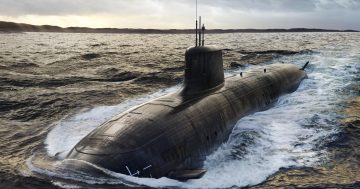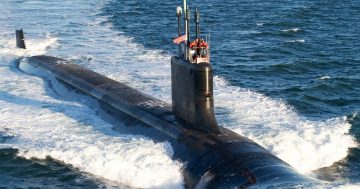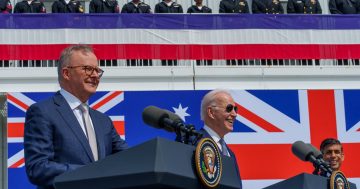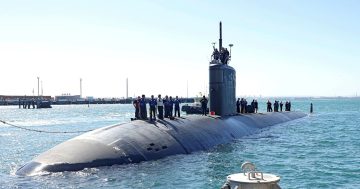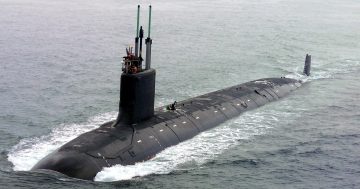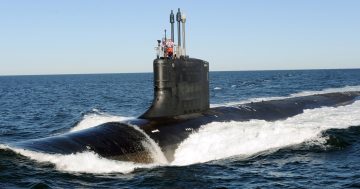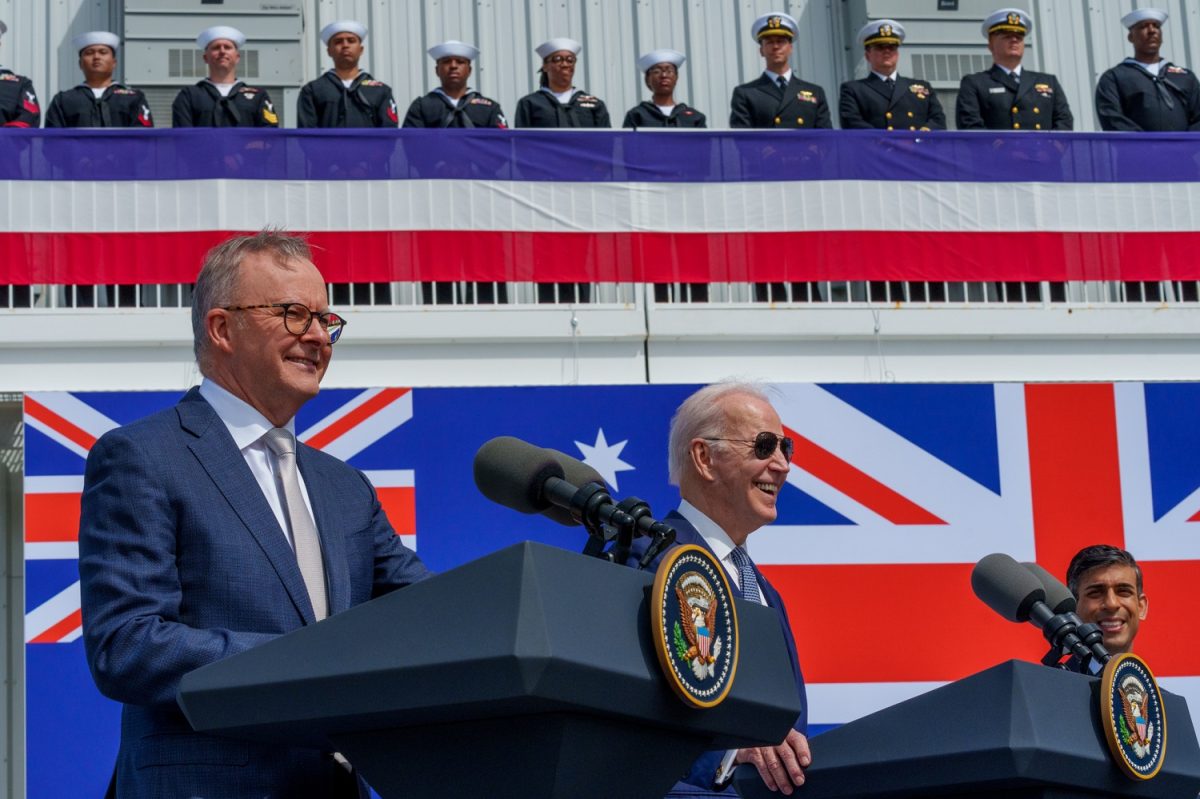
Prime Minister Anthony Albanese, US President Joe Biden, and British PM Rishi Sunak announce the AUKUS submarine arrangement in San Diego on Monday afternoon. Photo: PMO social media.
Australia will take delivery of up to five Virginia-class nuclear-powered attack submarines (SSN) from the early 2030s and will then acquire eight UK-designed next-generation ‘SSN-AUKUS’ attack submarines and become a development partner in that program from the early 2040s.
The three-phased plan – or “optimal pathway” to an Australian nuclear-powered submarine capability – was revealed by Prime Minister Anthony Albanese, US President Joe Biden and British PM Rishi Sunak in a joint announcement held pier-side at San Diego in California in front of a US Navy Virginia-class boat on Tuesday morning (14 March) Canberra time.
“In September 2021, Australia, the United Kingdom and the United States announced AUKUS – a new security partnership that will promote a free and open Indo-Pacific that is secure and stable,” a joint statement by the three leaders reads.
“The first major initiative of AUKUS was our historic trilateral decision to support Australia acquiring conventionally armed, nuclear-powered submarines. Today, we announce our pathway to achieve this critical capability.
“Together we will deliver SSN-AUKUS – a trilaterally developed submarine based on the United Kingdom’s next-generation design that incorporates technology from all three nations, including cutting-edge US submarine technologies,” it says.
“Australia and the United Kingdom will operate SSN-AUKUS as their submarine of the future. Australia and the United Kingdom will begin work to build SSN-AUKUS in their domestic shipyards within this decade.”
“When we announced the AUKUS partnership in September 2021, we committed to set the highest nuclear non-proliferation standard. The plan we announce today delivers on this commitment and reflects our longstanding leadership in, and respect for, the global nuclear non-proliferation regime. We continue to consult with the International Atomic Energy Agency to develop a non-proliferation approach that sets the strongest precedent for the acquisition of a nuclear-powered submarine capability.”
The deal will see Australia take three Virginia-class boats – pending US Congressional approval – and retain an option for an additional two vessels. However, the statement didn’t say whether these will be new-build submarines or, as has been widely reported, former US Navy boats. It is unlikely Australia will want to operate two different classes of SSN, so the possibility of the Virginias being former US boats is more likely.
The delivery of the Virginia-class boats will allow Australia to retire some or all of its Collins-class submarines. While more details are expected in the public version of the Defence Strategic Review due to be released next month, a plan to conduct a substantial life-of-type extension (LOTE) upgrade on the six-strong Collins fleet from 2024 will likely be scaled back, although some upgrade work will be required to keep these boats operationally viable until their withdrawal.
The SSN-AUKUS will combine the best US and UK submarine technologies to replace the Astute-class boats in Royal Navy service from the late 2030s, while Australia will take its first SSN-AUKUS boats in the early 2040s. It is unlikely that Australia’s first boats will be built locally; instead, the Osborne shipyard in Adelaide will initially build components or modules for all SSN-AUKUS boats while it ramps up its own manufacturing capabilities and workforce.
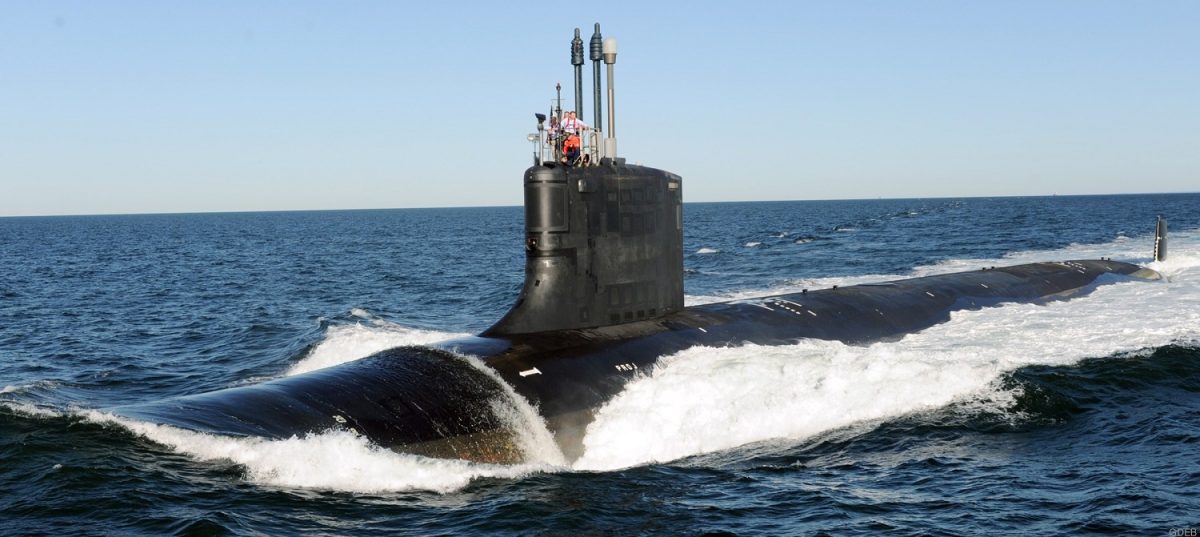
Virginia-class SSN, USS Missouri. Photo: US Navy.
The plan – which will reportedly cost north of an eye-watering $360 billion – is by far the largest defence procurement program in Australia’s history, although it is unclear what costs are included in that number.
Apart from the acquisition of the 11 to 13 new boats, other costs will likely include the construction of an east coast submarine base (reportedly at Port Kembla), the upgrade of the west coast base at HMAS Stirling near Fremantle, the development of a nuclear industry in Australia including the ramp-up of training courses and facilities for nuclear engineers and other specialist trades, maintenance and sustainment of the submarine capability through its life, and possibly complementary capabilities such as uncrewed or autonomous underwater vehicles (AUV), fixed underwater sonar arrays around Australia’s northern maritime approaches, and their support vessels and systems.
The plan will substantially increase Australia’s maritime capabilities and complement US and UK capabilities by adding fully interoperable submarines to the alliance to counter the massive build-up by China in the Indo-Pacific region.
The leaders’ joint statement said that Australian personnel will train with US Navy and Royal Navy nuclear submarine forces from this year to begin the learning process of operating these complex boats and that US and UK boats will be forward-deployed to HMAS Stirling to augment Australia’s Collins-class boats until the first Australian Virginias enter service.
“Beginning in 2023, Australian military and civilian personnel will embed with the US Navy, the Royal Navy, and in the United States and United Kingdom submarine industrial bases to accelerate the training of Australian personnel,” the joint statement reads.
“The United States plans to increase SSN port visits to Australia beginning in 2023, with Australian sailors joining US crews for training and development; the United Kingdom will increase visits to Australia beginning in 2026.”
The joint statement focussed solely on the submarine announcement and didn’t touch on Pillar 2 of the AUKUS construct which will allow for joint development of advanced cyber capabilities, hypersonic weapons, artificial intelligence and other technologies. It is expected details of some of these elements will be revealed in the Defence Strategic Review or in the new Defence Integrated Investment Plan (IIP), which is expected to follow later this year.












